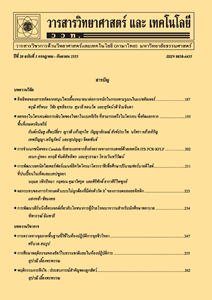การพัฒนาเทคนิคการวิเคราะห์ปริมาณเหล็ก(III) โดยใช้สารสกัดแอนโทไซยานินจากธรรมชาติตรวจวัดด้วยสมาร์ทโฟน
Main Article Content
Abstract
The method for determination of Fe(III) using complex formation reaction between the extracted purple cabbage and Fe(III) detected by smartphone was developed in this work. Adobe Photoshop CS6 program for photos evaluation from the smartphone was used. The parameters affecting the analytical results were studied for instant optimal conditions for extraction and photo taking. The obtained results showed that distilled water was an optimal condition for purple cabbage powder extraction. In addition, photography taken under the white sample holder with a focusing distance of 10 cm in natural light on the scene was an optimal condition for photo taking. Under the optimum conditions, linearity range was in the range of 100-900 µM with correlation coefficient (r2) of 0.9966 (linearity equation: y = 0.0001x + 0.0190) and limit of detection (3sd) was 73 µM. Moreover, the performance of the proposed method has been compared to that of UV-Vis spectrophotometric method as a standard method. According to the paired t-test, the results of the two methods are not significantly different at 95 % confidence (tstat = 0.09, tcritical = 3.18).
Article Details
References
Gałuszka, A., Migaszewski, Z. and Namiesnik, J., 2013, The 12 principles of green analytical chemistry and the SIGNIFICANCE mnemonic of green analytical practices, Trends Anal. Chem. 50: 78-84.
Qian, B.J., Wu, C.F., Lu, M.M., Xu, W. and Jing, P., 2017, Effect of complexes of cyanidin-3-diglucoside-5-glucoside with rutin and metal ions on their antioxidant activities, Food Chem. 232: 545–551.
Khaodee, W., Auangmaitreepirom, W. and Tuntulani, T., 2014, Effectively simulta neous naked-eye detection of Cu(II), Pb(II), Al(III) and Fe(III) using cyanidin extracted from red cabbage as chelating agent, Spectrochim. Acta Part A Mol. Biomol. Spectrosc. 126: 98-104.
Jaikrajang, N., Kruanetr, S., Harding, D.J. and Rattanakit, P., 2018, A simple flow injection spectrophotometric procedure for iron(III) determination using Phyllanthus emblica Linn. as a natural reagent, Spectrochim. Acta Part A Mol. Biomol. Spectrosc. 204: 726-734.
Charoenteeraboon, J., Ngamkitidechakul, C., Soonthornchareonnon, N., Jaijoy, K. and Seewaboon Sireeratawong, S., 2010, Antioxidant activities of the standardized water extract from fruit of Phyllanthus emblica Linn., Songklanakarin J. Sci. Technol. 32: 599-604.
Khan, A., Ahmed, T., Rizwan, M. and Khan, N., 2018, Comparative therapeutic efficacy of Phyllanthus emblica (Amla) fruit extract and procaine penicillin in the treatment of subclinical mastitis in dairy buffaloes, Microb. Pathog. 115: 8-11.
Wattanayon, R., Satapor, S., Yama, B., Samanman, S. and Vangsirigul, P., 2017, Determination of iron ion using anthocyanin from roselle, Princ. Naradhiwas Univ. J. 9(2): 97-103. (in Thai)
Khaodee, W., Wongkiti, R. and Madang, S., 2017, Naked-Eye Detection of lead ion in water sample using reagent extracted from white dragon fruit peel, KKU Sci. J. 45(4): 886-895. (in Thai)
Ali, R.A.M. and Nayan, N., 2010, Fabrication and analysis of dye-sensitized solar cell using natural dye extracted from dragon fruit, Int. J. Integr. Eng. 2: 55-62.
Wulansari, D., Desmiaty, Y. and Purwitosari, E., 2007, The comparison of two colorimetric methods for determination of total tannin in Psidium guajava L. Leaves by Folin-Ciocalteu’s and 1,10-phenenthroline reagents, pp. 1-6, The International Conference on Traditional Medicine and Medicinal Plants, Surabaya.
Saptarini, N.M., Suryasaputra, D. and Nurmalia, H., 2015, Application of Butterfly Pea (Clitoria ternatea Linn.) extract as an indicator of acid-base titration, J. Chem. Pharm. Res. 7: 275-280.
Kamkaen, N. and Wilkinson, J.M., 2009, The antioxidant activity of Clitoria ternatea flower petal extracts and eye gel, Phytother. Res. 23: 1624-1625.
Sukaram, T., Sirisakwisut, P. and Chaneam, S., 2017, Use of natural pigment from orchid as a reagent for quantitative analysis of ammonia in chemical fertilizers, Burapha Sci. J. 22: 366-376. (in Thai)
Moonrangsee, N., Prachain, C., Bumrungkij, C. and Peamaroon, N., 2018, A simple device with a smartphone camara for determination of salicylic acid in food, drugs and cosmetrics, J. KMUTNB. 28(3): 639-648. (in Thai)
Martinkova, P. and Pohanka, M., 2016, Colorimetric sensor based on bubble wrap and camera phone for glucose determination, J. Appl. Biomed. 14: 315-319.
Moonrungsee, N., Pencharee, S. and Jakmunee, J., 2015, Colorimetric analyzer based on mobile phone camera for determination of available phosphorus in soil, Talanta 136: 204-209.
Choodum, A., Kanatharana, P., Wongnira maikul, W. and Daeid, N.N., 2013, Using the IPhone as a device for a rapid quantitative analysis of trinitrotoluene in soil, Talanta 115: 143-149.
Pragourpuna, K., Sakeea, U., Fernandezb, C. and Kruanetra, S, 2015, Deferiprone, a non-toxic reagent for determination of iron in samples via sequential injection analysis, Spectrochim. Acta Part A Mol. Biomol. Spectrosc. 142: 110-117.
Viprakasit, V., 2009, Clinical Practice Guideline for Deferiprone in Patients with Iron Overload, 1st Ed., Government Pharmaceutical Organization, 36 p. (in Thai)
Pichayajittipong, P., 2013, Production and biological properties of food colorants from red dragon fruit (Hylocercus polyrhizus) peels, Master Thesis, Suranaree University of Technology, Nakhon Ratchasima, 40 p. (in Thai)
Palachai, P. and Muncharoen, S., 2017, A simple experiment to evaluate the equilibrium constant of bromothymol blue using smart phone for high school students, Srinakharinwirot Sci. J. 33(2): 213-228. (in Thai)
Chigurupati, N., Saiki, L., Gayser, C.Jr. and Dash, A.K., 2002, Evaluation of red cabbage dye as a potential natural color for pharmaceutical use, Int. J. Pharm. 241: 293-299.


